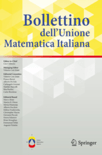
BOLLETTINO DELLA UNIONE MATEMATICA ITALIANA
Scope & Guideline
Showcasing Innovative Ideas in Miscellaneous Mathematics
Introduction
Aims and Scopes
- Algebra and Geometry:
The journal frequently publishes papers that explore algebraic structures, such as commutators of matrices, Galois representations, and properties of algebraic varieties. This area seeks to understand the deep connections between algebra and geometric properties. - Functional Analysis and Operator Theory:
Research in this domain often involves the study of differential equations, operator theory, and functional spaces. Papers highlight various techniques for analyzing stability, convergence, and operator properties. - Applied Mathematics and Mathematical Physics:
The journal includes studies that bridge mathematics with physical applications, such as stability in fluid dynamics, mathematical modeling of physical phenomena, and the use of mathematical frameworks in understanding complex systems. - Numerical Methods and Computational Mathematics:
Numerical analysis papers focus on algorithms and computational techniques for solving mathematical problems, including optimization methods and numerical simulations relevant to practical applications. - Topology and Homotopy Theory:
This area encompasses research on the properties of topological spaces, homotopy types, and related concepts, contributing to the understanding of complex structures in mathematics. - Mathematical Education and Pedagogy:
The journal also addresses the educational aspects of mathematics, exploring innovative teaching methods and frameworks for enhancing mathematical understanding.
Trending and Emerging
- Interdisciplinary Applications of Mathematics:
There is an increasing trend towards papers that apply mathematical concepts to fields such as physics, engineering, and data science, highlighting the importance of mathematics in solving real-world problems. - Machine Learning and Data Science:
Recent publications indicate a growing interest in the intersection of mathematics with machine learning techniques, emphasizing the need for mathematical rigor in developing algorithms and models. - Complex Systems and Nonlinear Dynamics:
Research focusing on complex systems and their dynamics is on the rise, with papers exploring topics like chaos theory, stability in nonlinear systems, and applications in various scientific fields. - Functional and Fractional Analysis:
There is a notable increase in studies related to functional and fractional analysis, particularly concerning their applications in solving differential equations and optimization problems. - Mathematical Modeling of Biological Systems:
Emerging themes include the mathematical modeling of biological systems, particularly in epidemiology and population dynamics, reflecting the relevance of mathematics in understanding biological phenomena.
Declining or Waning
- Classical Number Theory:
Papers related to classical number theory, such as those focusing on prime numbers and modular forms, have become less frequent in recent issues, indicating a potential shift towards more contemporary and applied mathematical topics. - Elementary Geometry:
Research that pertains to traditional topics in elementary geometry seems to have waned, with fewer submissions exploring basic geometric principles or constructs, suggesting a shift to more abstract or complex geometric theories. - Historical Mathematics:
The exploration of historical mathematical concepts and figures, while still relevant, has seen a reduction in focus, possibly overshadowed by more contemporary research trends and applications. - Purely Theoretical Mathematical Problems:
There appears to be a declining interest in problems that are purely theoretical without immediate applications, as more papers seem to focus on interdisciplinary approaches and applied mathematics.
Similar Journals
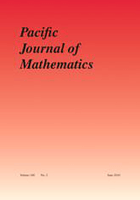
PACIFIC JOURNAL OF MATHEMATICS
Exploring the Depths of Mathematics with Rigorous ScholarshipThe PACIFIC JOURNAL OF MATHEMATICS, established in 1951 and published by Mathematical Sciences Publishers, is a premier peer-reviewed journal in the field of mathematics, renowned for its rigorous scholarship and impactful research contributions. With an HIndex that reflects its sustained academic influence, this journal has been categorized within the Q1 quartile in the field of mathematics (miscellaneous) as of 2023, showcasing its position among the top-tier mathematics journals globally. Although the journal operates under a traditional subscription model rather than an Open Access format, it remains dedicated to disseminating original research that spans various domains within mathematics. Researchers, professionals, and students alike will find the journal's breadth of topics and commitment to quality work instrumental in advancing their understanding and exploration of mathematical concepts. This esteemed journal continues to thrive as a vital resource for the mathematical community through its comprehensive collection of articles from a diverse range of mathematical disciplines, thus maintaining a significant role in shaping the future of mathematical inquiry.
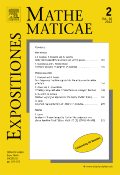
EXPOSITIONES MATHEMATICAE
Fostering Original Research in Diverse Mathematical FieldsEXPOSITIONES MATHEMATICAE, published by Elsevier GmbH, stands as a significant journal in the realm of mathematics, catering primarily to researchers, professionals, and students. With an ISSN of 0723-0869 and an E-ISSN of 1878-0792, this journal has made its mark in the academic community, boasting a Q2 classification in the miscellaneous mathematics category for 2023, illustrating its prominence within its field. The journal addresses a diverse scope of mathematical topics, encouraging the publication of original research and innovative theories while maintaining rigorous academic standards. As it converges from 2004 to 2024, EXPOSITIONES MATHEMATICAE continues to be an essential resource for advancing mathematical knowledge and fostering scholarly communication, despite being a non-open-access publication. Its location in Munich, Germany further anchors it within a rich intellectual tradition, providing accessibility for the mathematical community worldwide.

Results in Mathematics
Cultivating a Community of Mathematical Excellence.Results in Mathematics, published by SPRINGER BASEL AG, is a prestigious academic journal dedicated to advancing the field of mathematics since its inception in 1978. Based in Switzerland, this journal has garnered a significant reputation, holding a Q2 ranking in both Applied Mathematics and miscellaneous Mathematics categories according to the latest 2023 metrics. The journal is a vital resource for researchers, professionals, and students, encouraging open dialogue about emerging mathematical concepts and methodologies. Our editorial objective is to publish high-quality research articles that contribute to theoretical advancements and practical applications in mathematics. Although it does not currently offer open access options, it provides in-depth studies and articles that fortify the knowledge base within the mathematical community. With a commitment to innovation and academic rigor, Results in Mathematics continues to serve as an essential platform for scholarly communication and exploration.

Ukrainian Mathematical Journal
Nurturing Knowledge in the Mathematical CommunityThe Ukrainian Mathematical Journal is a prominent academic publication in the field of mathematics, focusing on a diverse range of topics that appeal to researchers, professionals, and students alike. Published by Springer, this journal has been an important platform for disseminating significant mathematical research since its inception in 1957. With the aim of fostering knowledge and collaboration within the mathematical community, the journal curates high-quality articles that meet rigorous scholarly standards, evidenced by its Q3 ranking in the miscellaneous mathematics category for 2023. Although it currently does not offer open access, the journal remains accessible through various institutional subscriptions. It serves as a vital resource for ongoing discourse in the field and invites contributions that further advance mathematical understanding.
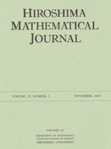
Hiroshima Mathematical Journal
Exploring the Depths of Algebra, Analysis, and BeyondThe Hiroshima Mathematical Journal, published by Hiroshima University, Graduate School of Science, serves as a prominent platform for disseminating high-quality research in the field of mathematics. Established in 1959, the journal has been an integral part of the mathematical community, focusing on areas such as Algebra, Number Theory, Analysis, and Geometry and Topology. Although currently classified in Q4 quartile rankings within its categories, the journal is committed to advancing mathematical knowledge and fostering scholarly dialogue. Its accessibility, combined with its long-standing history, makes it an essential resource for researchers, professionals, and students dedicated to exploring and enhancing the mathematical sciences. For those interested in contributing or accessing cutting-edge research, the Hiroshima Mathematical Journal continues to uphold its mission of excellence in mathematical scholarship.

Periodica Mathematica Hungarica
Fostering Excellence in Mathematical Research and Applications.Periodica Mathematica Hungarica is a prestigious academic journal published by Springer, focusing on the field of mathematics, with a particular emphasis on miscellaneous mathematical studies. Established in 1971, this journal has maintained its commitment to advancing mathematical research and its applications, making significant contributions over its converged years through 2024. With a Q2 ranking in the mathematics category as of 2023, it establishes itself as a vital resource within the mathematical community. Researchers and academics will find its inclusion in the Scopus database, ranking #189 out of 399 in general mathematics, indicative of its impact and relevance. Although it does not feature open access, the journal provides a wealth of high-quality peer-reviewed articles, thereby serving as an essential platform for the dissemination of innovative mathematical theories, methodologies, and findings. Engaging with the content of Periodica Mathematica Hungarica is crucial for anyone looking to stay at the forefront of mathematical research and development.

Bulletin of the Iranian Mathematical Society
Empowering researchers to share groundbreaking mathematical insights.The Bulletin of the Iranian Mathematical Society, published by SPRINGER SINGAPORE PTE LTD, is a distinguished journal dedicated to advancing the field of mathematics. With an ISSN of 1017-060X and E-ISSN 1735-8515, this journal has established a valuable platform for researchers and scholars to disseminate their findings from 2008 to 2024. The journal is categorized in the Q2 tier of Mathematics (miscellaneous) for 2023, showcasing its importance and relevance in the mathematical community, ranked #169 out of 399 in General Mathematics with a 57th percentile standing in Scopus. While currently operating under a subscription model, it remains an essential resource for professionals and students seeking cutting-edge research and developments in various domains of mathematics. The Bulletin aims to bridge theoretical research and practical application, thereby enriching both academia and industry.
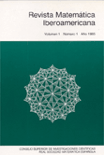
REVISTA MATEMATICA IBEROAMERICANA
Bridging theory and application in mathematical studies.REVISTA MATEMATICA IBEROAMERICANA, published by the EUROPEAN MATHEMATICAL SOCIETY, is a leading open-access journal dedicated to advancing the field of mathematics. Since its inception in 1996, the journal has provided a platform for high-quality research up to 2024, achieving a prestigious Q1 ranking in the miscellaneous mathematics category and placing it within the top 77th percentile of the Scopus rankings. Based in Spain, this journal fosters a vibrant academic community by disseminating innovative research, theoretical insights, and applications within the broad scope of mathematics. With its commitment to open access established in 2022, REVISTA MATEMATICA IBEROAMERICANA ensures that groundbreaking research is accessible to scholars, practitioners, and students worldwide, emphasizing the importance of collaboration and knowledge sharing in the mathematical sciences. The journal is a vital resource for anyone invested in the evolution of mathematics, providing a rich array of articles that contribute to both the theoretical and applied landscapes of the discipline.

INDIAN JOURNAL OF PURE & APPLIED MATHEMATICS
Elevating Research Standards in MathematicsINDIAN JOURNAL OF PURE & APPLIED MATHEMATICS, published by the INDIAN NATIONAL SCIENCE ACADEMY, stands as a vital resource in the realm of pure and applied mathematics since its inception in 1996. With ISSN 0019-5588 and E-ISSN 0975-7465, this journal aims to disseminate original research that advances the understanding and application of mathematical principles. Operating out of New Delhi, India, it serves a diverse readership comprising researchers, scholars, and practitioners in the mathematical sciences. Recognized within the Q3 category in both Applied Mathematics and Miscellaneous Mathematics as per the 2023 category quartiles, the journal emphasizes rigorous peer-reviewed articles that contribute to its impact in academia, reflected in its Scopus rankings. Although it does not currently operate as an open-access journal, it maintains a commitment to quality and accessibility of scholarly content, striving to foster academic collaboration and innovation. The convergence of full-text issues from 1996 to 2024 highlights its ongoing dedication to the evolution of mathematical research.
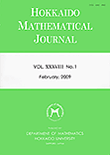
Hokkaido Mathematical Journal
Uniting mathematicians in pursuit of knowledge and discovery.Hokkaido Mathematical Journal, published by Hokkaido University, Department of Mathematics, stands as a pivotal platform for scholarly discourse in the field of mathematics. Established in 1972, this peer-reviewed journal has consistently contributed to the advancement of mathematical research, covering a wide spectrum of topics within the discipline. With its current ranking in the third quartile (Q3) among miscellaneous mathematics journals, it offers valuable insights and findings that cater to both established researchers and budding mathematicians alike. The journal is accessible through traditional subscription, fostering a community that values rigorous theoretical exploration and applied mathematical methods. As it approaches its convergence year in 2024, Hokkaido Mathematical Journal remains essential for those dedicated to pushing the boundaries of mathematical knowledge and innovation in Japan and beyond.